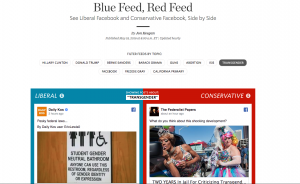 If you were on Facebook last month, you might have felt like Alice tumbling down the rabbit hole when you noticed Facebook on its own “Trending” sidebar. Several former employees admitted to manipulating the Trending feed. They frequently introduced topics they thought deserved more coverage and occasionally suppressed conservative commentary by choosing different sources for topics that would appeal to conservatives.
If you were on Facebook last month, you might have felt like Alice tumbling down the rabbit hole when you noticed Facebook on its own “Trending” sidebar. Several former employees admitted to manipulating the Trending feed. They frequently introduced topics they thought deserved more coverage and occasionally suppressed conservative commentary by choosing different sources for topics that would appeal to conservatives.
Since the news went viral, Facebook has been doing damage control. They’ve issued statements, invited well-known conservatives to the conversation, and made changes to minimize the human element and ensure that the Facebook Trending sidebar will live up to the ideal of being objective and fair.
One Facebook
The topics on the Trending feed are influential, but what shows up in our personal news feeds is even more so. The algorithms that deliver tailored news feeds are based on our political leanings. Facebook knows how we lean because of the information we provide (on our bio page, interests, etc.) and through our activity on Facebook’s site (what you like, search for, or share).
Two Worlds
The Wall Street Journal has undertaken an experiment to show the stark contrast in news feeds for liberal-leaning users vs. conservative-leaning users. In “Red Feed, Blue Feed,” you can pick a topic and then see the kinds of articles that show up on a conservative’s timeline or a liberal’s timeline. The timelines are updated every hour.
On the day I visited the site, I picked “transgender.” On the liberal timeline was a story of a transgender woman who served in the military but faces rejection from conservatives. The story was sympathetic to the plight of transgender persons and their acceptance in society. On the conservative timeline was a story of a transgender teacher who won $60,000 after co-workers refused to give her the gender-neutral pronoun “they.” The story reinforced the craziness of a politically correct culture.
I scrolled down the timelines and saw stories that mocked leaders who are concerned about public school bathrooms, or that mocked over-the-top expressions of gender and the government’s interference.
I felt sick.
I did the same for the other topics, including and “Freddie Gray.” I clicked on the coverage of Hillary Clinton and Donald Trump. Then, I shifted over to “abortion” and watched how the liberal timeline focused on women in distress and how the conservative timeline focused on the violence of abortion and its harmfulness.
Three Problems
Looking at the timelines side by side, I realized why civil discourse in the age of Facebook is so challenging.
1. It is hard to have conversations across the aisle, or across the Facebook Gap, when groups get revved up about different things.
The Planned Parenthood videos reignited pro-life passion and debate last year, but conservatives were surprised that so many pro-choice lawmakers said they had not seen the videos. Pro-choice advocates thought all of the controversy was just a hyped-up way of scoring political points. Look at the timelines and you can see why. It’s likely that many pro-life people saw dozens of commentaries and news stories on the issue, while many pro-choice people saw only an occasional article “discrediting” the video-makers.
The same is true of Black Lives Matter and the ongoing tension between police officers and the African-American community. Look at the timelines for Freddie Gray and you will see vastly different narratives. Is it any wonder that many conservatives see the complaints of minority communities as just hype or as self-inflicted chaos, while others see in these protests the next wave of the Civil Rights movement?
2. Talk is hard in a tailored world.
We don’t see the same stories, and, as a result of the stories we do see, we are (1) less informed and (2) more affirmed.
The tailoring of our news feed leads us to assume that everyone sees what we see, and then we assume the worst of the people around us. How can they think that way? we wonder. They must be either stupid or evil!
3. A steady dose of your “red” or “blue” feed on sensitive issues will reinforce whatever you already think to be the case.
I’m glad The Wall Street Journal took on this project. Read news from your desired slant over and over again and you create a self-righteous loop: You are right. They are crazy. You are right. They are crazy.
What to Do?
Christians have the opportunity to recognize the problem here and show a better way.
Let’s confuse the algorithms.
Let’s consult news sources and websites from people on the other side of the aisle.
Let’s become experts at recognizing the slant in the news and commentary we come across, whether it be from the right or the left.
Let’s reject the tendency to assume the worst in our political opponents and take umbrage at every perceived slight.
Let’s learn how to express the perspectives of our opponents so well that they agree with our characterizations, even if in the end, we still disagree.
When we are united by outrage, we look and sound just like the world. So let’s think about the long-term formative effect of our Facebook feeds that reinforce our righteousness, and figure out ways to respond with cheerful confidence in God’s good purposes for the world.


















